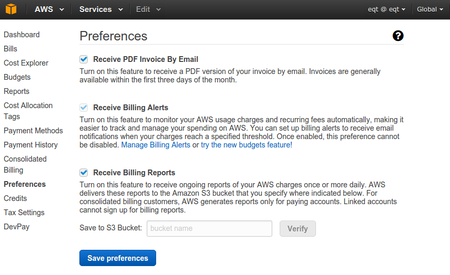AWS
Amazon Web Services, or AWS, is the cloud service offering from Amazon.

| Warning: While I have professional expertise in AWS Cloud, I may color these notes with my personal opinions to cut to the root of the issues and not sound like another AWS promoter. I do encourage corporate use of AWS Cloud, and hiring me to navigate the complexity. I may own AMZN stock. |
Amazon has a huge product and services portfolio, so it can be a lot of work to get to the best solution. And taking a lesson from NYC taxi cabs, the meter is always running. For example, you can receive billing alerts, but you can't turn the feature off (so you'll end up ignoring the onslaught of useless emails until you actually miss some invoice that is important). They realize that customers want to know what/where/when/how much their bill is, so they created a different "service" they call budgets that will let you know what your bill will be. And guess what? They charge for the service! They also have a separate Billing Report service. This one generates reports once OR MORE, daily. Instead of delivering these reports via email, they deposit them into storage that they charge for. You pay for the storage, and then you get reports about how much the storage costs, and the reports go into the storage bucket. I imagine at some point they'll just embed 1GB image files in the report so that they can charge a ton of money for the storage of the reports that tell you how much storage you're using.
Once you have an account, you can interact in several ways. There is of course the browser-based 'console' which is overwhelming and complicated. Then there is also the console-based commands when logged into an instance. That is referred to as the AWS CLI [1]. But thankfully, there are a couple of command-line toolsets for manipulating the API and also Amazon Machine Images (AMI) right from the comfort of your own home.
- http://docs.aws.amazon.com/AWSEC2/latest/CommandLineReference/set-up-ec2-cli-linux.html Getting setup
- http://docs.aws.amazon.com/AWSEC2/latest/CommandLineReference/Welcome.html
- http://docs.aws.amazon.com/AWSEC2/latest/CommandLineReference/command-reference.html
- Amazon EC2 API Tools The API tools serve as the client interface to the Amazon EC2 web service. Use these tools to register and launch instances, manipulate security groups, and more.
- Amazon EC2 AMI Tools are command-line utilities to bundle an Amazon Machine Image (AMI), create an AMI from an existing machine or installed volume, and upload a bundled AMI to Amazon S3.
Example Commands[edit]
You can find multiple links to example commands (and there are corresponding GitHub repos) listed at userguide/cli-chap-code-examples.html while the userguide/cli_code_examples.html page links to actual command examples.
Example aws-cli commands[edit]
Setup your CLI with the configure command. If you need to access multiple AWS accounts (e.g. personal vs work or multiple consulting customers), then use the --profile option.
aws configure --profile wall-st-billionaire
aws account get-contact-information
Example ec2-cli commands[edit]
ec2-describe-instances
ec2-stop-instances i-ca51833a
ec2-terminate-instances -h
Info[edit]
- Thread about AWS stuff you wish you knew in advance: https://news.ycombinator.com/item?id=7172060
- "matrix" of EC2 server offerings
- A much better representation of EC2 server offerings
- If you need to work with "serverless" applications in AWS, see the AWS Toolkit for Visual Studio Code This extension makes it easier for developers to develop, debug locally, and deploy those serverless applications into AWS. If you're working with regular EC2 instances, you connect to those using remote SSH normally with an entry in your
.ssh/config.
Amazon Linux[edit]
AWS created their own Linux derivative distribution. See https://docs.aws.amazon.com/linux/al2023/ug/base-container.html if you need to work with their "2023" version.
SubPages[edit]